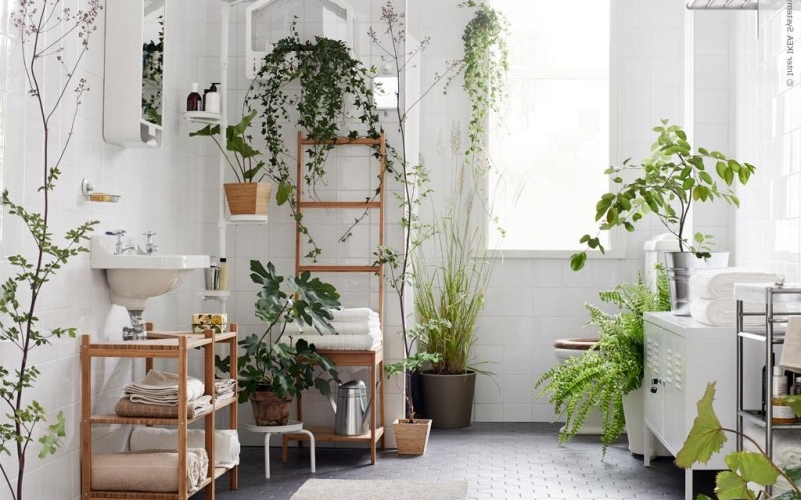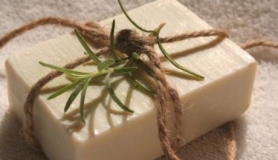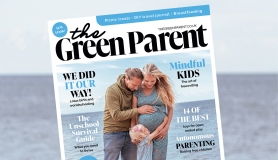CHOOSE NATURAL
When cleaning your bathroom choose items closest to nature. Lemon juice and vinegar can be put to good use around the bathroom. For example to get a good shine on your taps wrap a cloth soaked in vinegar around the tap overnight. Bicarbonate of soda can be used as an effective toilet cleaner. If you buy cleaning products check out biggreensmile.com, greenbrands.co.uk and pravera.co.uk. We also like the cleaning products at celticsustainables.co.uk for more heavy duty jobs.
SMELLS LIKE NATURE
When cleaning the bathroom, pine essential oil can be used to create a fresh fragrance. Add a drop to the toilet after cleaning. Create a refreshing room spray using water with two drops of lemongrass, lavender and tea tree oil added. Try tisserand.com for essential oils or homescents.co.uk for pre-blended natural room sprays.
USE THE SUN
A solar water heater can reduce CO2 emissions by up to 2.5 tonnes in the average house. The system uses solar panels, called collectors, which are fitted to your roof. These collect heat from the sun and use it to warm water, which is stored in a hot water cylinder. Contrary to popular belief they do not need full sunlight to heat up. Diffuse light works just as well, although it’s likely that you will need to use your boiler to top it up in the winter months. See energysavingtrust.org.uk for more details. There are grants available, such as the Green Deal. You can also learn how to make your own low cost system at solarfriend.co.uk.
RECLAIMED GOODS
When doing up a bathroom, look for reclaimed or vintage building materials and equipment such as baths, radiators and wooden floors. See salvoweb.com for suppliers and products and check out etsy.com for vintage items. Also get involved with your local freegling network to find out whether there is anything suitable in your local area.
BRUSH WITH CARE
To avoid wasting water when brushing your teeth, fill a small cup with water and use this to rinse your toothbrush between brushes. We can waste up to six litres of water by leaving the tap on when brushing our teeth. Look out for natural toothpastes that contain no SLS. Try brands like Lavera, Green People or Toms of Maine.
HARVEST THE RAIN
Flushing the toilet accounts for a third of our daily water usage. Invest in a rainwater collection system so that you can use rainwater rather than drinking water to flush your loo. See rainwaterharvesting.co.uk for more details. It is also possible to create a system where your bath water is used to flush the toilet. Ask your plumber if he can help.
SHOWER OR SHARE
The average bath uses 80 litters of water whilst a shower uses between 30 – 49 litres. Either take a short shower with a shower timer (check out showerbob.co.uk, who allows you a 4 minute wash) or share your bath with someone you love.
MORE WAYS TO SAVE WATER
There are other ways to save water in the bathroom. Spray taps for example let out a lesser volume of water but are not very different to normal taps. A dual flush toilet (available from greenbuildingstore.co.uk) releases more water for solid waste and less for liquid waste. Low-flow showerheads (like the one at ecocamel.com) can also be fitted and they help to minimise the water used.
POP A BRICK IN IT
We use between 15 and 20 litres of water when flushing the toilet. In fact, flushing is responsible for 30% of water usage in the average home. Help reduce your water consumption by placing a hippo (hippo-the-watersaver.co.uk) or a brick in your water cistern. Get more ideas at waterwise.org.uk.
CHOOSE RECYCLED
On average we use 110 rolls of toilet paper every year. In the UK, less than 10% of this is recycled, which means that it is created from virgin forest in Scandinavia. Save trees and choose recycled instead. See biggreensmile.com or goodnessdirect.co.uk.
GIVE A CUP A TRY
We can use up to 11,000 tampons in a lifetime – which get flushed into the water system or end up in landfill. Thankfully there’s a much greener and cleaner option and that’s a reusable menstrual cup – available from mooncup.co.uk or femmecup.co.uk. They are easy to use and revolutionise your periods. Another option is washable sanitary pads, available from earthwisegirls.co.uk or find out how to make your own at stewardwood.org/resources/DIYwashabletowels.htm.
ORGANIC BEAUTY
Every year we absorb around 2kg of chemicals through toiletries and cosmetics. Switch to natural and organic products and reduce the amount of products that you use and your health and pocket will benefit. Check out lovelula.com, nealsyardremedies.com and birchbox.com for natural brands.







